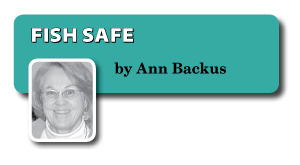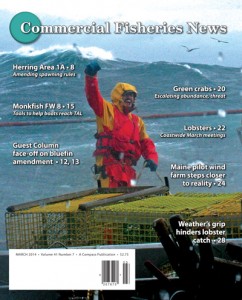In the January 2014 CFN, we discussed the hazards associated with winch level-winding operations on trawlers based on our ongoing Northeast Drum Winch Safety Improvement Study. This time, we’ll look at what we have learned about drum winch emergency shutoffs.
To recap, we collected data for the study on 54 vessels from Gloucester, New Bedford, Point Judith, and Martha’s Vineyard. The drum winches aboard these vessels generally were the “split” type. That is, they used two separate drums for hauling cable as opposed to side-by-side double drums.
 In this fleet, drum winches generally were located on the mid-deck (73%) or on the pilothouse deck (11%). The pilothouse deck location was characteristic of the larger boats we surveyed. These winches were out of the way of the crew, and captains controlled the winches, including the emergency shutoff, from the pilothouse.
In this fleet, drum winches generally were located on the mid-deck (73%) or on the pilothouse deck (11%). The pilothouse deck location was characteristic of the larger boats we surveyed. These winches were out of the way of the crew, and captains controlled the winches, including the emergency shutoff, from the pilothouse.
In contrast, winches located mid-deck presented considerable hazards. Crewmembers could be working at them, manually level winding, or could be in the vicinity of the drum and the cable as it was winding up or paying out.
Of the winches in the mid-deck configuration, 37% were controlled by spool valves and did not have an emergency shutoff that was closer to the drum than one arm’s length. In some ports, this emergency shutoff is called a power take-off (PTO) switch.
In a hydraulic system with spool valves, the operator can set the lever or levers to the hauling position and then walk away to engage in another task, leaving the drum to continue to revolve and wind the cable. In other words, it’s possible that no crewmember would beat the controls during a haul-back operation.
If, in addition, there were no emergency shutoff within an arm’s length of the drum, there would be no way to stop the drum quickly if someone got caught during the cable-winding process.
In summary, this is the situation we considered to be very hazardous – a mid-deck spool-valve-operated winch without an emergency shutoff within an arm’s length of the drum.
In contrast, a pilothouse deck spool-valve-controlled winch is much less hazardous because the drums are out of the way of the crew and within the sightline of the captain, who most likely remains at the controls during any set-out or haul-back operations.
Another hazardous shutoff situation is the drum winch with the very old chain-and-sprocket direct drive mechanism. Surprisingly, there are still a number of these mechanisms on trawlers in the Northeast. I saw such a mechanism on a historical trawler displayed at the Working Waterfront Festival in New Bedford last September.
In contrast to a hydraulic system that can be shut down quickly, shutting down the chain-and-sprocket configured winch requires a strong fisherman to manually move the lever that disengages the chain from the sprockets. This is a sluggish and potentially dangerous system.
PTOs
When we asked captains whether they had emergency shutoffs or PTO switches on board, 89% reported that they did. However, 39% of these also reported that their shutoff switch was more than one arm’s length from the drum. That’s OK if someone is always at the controls, but not OK if the controls are left unattended.
In some configurations, we noticed that the PTO was around the corner from the drum and not easily accessible. We found that the one-man operation vessels in our study (15%) tended to have important safety features. Of the one-man vessels, 25% had spring-loaded valves that shut down the winch system when the valve is not held open, and 75% had PTO switches within an arm’s length of the drum.
In short, an emergency shutoff system that is immediately responsive and immediately accessible is the priority setup. But we also should
help prevent winch accidents by adopting rules about staying at the controls and away from the operating winch and by providing training and frequent reminders about the safe operation of winches.
We are in the process of having fishermen evaluate a hydraulic level wind design and an emergency shutoff. If you are interested in participating, please let me know by e-mail at <abackus@hsph.harvard.edu>.
Our funding for this study is through the Northeast Center for Agricultural and Occupational Health. n
Ann Backus, MS, is the director of outreach for the Harvard School of Public Health’s Department of Environmental Health in Boston, MA. She may be reached by phone at (617) 432-3327 or by e-mail at <abackus@hsph.harvard.edu>.
 Get the rest and much, much more in the March issue of Commercial Fisheries News.
Get the rest and much, much more in the March issue of Commercial Fisheries News.
Read online immediately and download for future reference.







 Updating...
Updating...